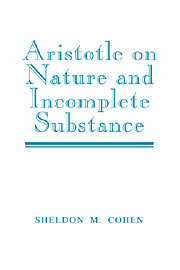2 - Elemental Motion and Alteration
Published online by Cambridge University Press: 05 June 2012
Summary
In Chapter 1 we saw Aristotle introduce the Internal Principle of Change Principle (IPCP), but it remained rather abstract and we did not see how Aristotle applies it to actual cases. In this chapter I discuss his use of the principle in his accounts of elemental motion and alteration. This develops the notion of an Internal Principle of Change (IPC) and, I argue, leads him to the view that things need not always possess all their essential properties, though they must by nature be disposed toward possessing them. We can think of this as a principle of essentialist generosity, balancing his tendency to a restricted and elitist essentialism mentioned in the Introduction. (On the one hand, some plebeian things do not have essences; on the other, things that have essences get credit for trying, even if they fail.) In Chapter 5 I return to this theme.
Aristotle's Elements
In On the Heavens III, 3, Aristotle gives the following definition: “An element … is a body into which other bodies may be analyzed, present in them potentially or actually … and not itself divisible into bodies different in form” [302a16–18]. He then goes on to say that fire and earth are potentially present in flesh and wood, for they can be drawn out of flesh and wood, but that flesh and wood are neither potentially nor or actually present in fire, for they cannot be drawn out of fire.
- Type
- Chapter
- Information
- Aristotle on Nature and Incomplete Substance , pp. 33 - 54Publisher: Cambridge University PressPrint publication year: 1996



